The ideal avocado tree fruits every year, and it makes approximately the same quantity of fruit every year. Alas, this ideal avocado tree is only a dream.
Nevertheless, there is a technique that can be used to manipulate an avocado tree into fruiting consistently: girdling.
Avocado growers in California have experimented with girdling in order to increase fruit production for more than 100 years. (See this article from the 1920-21 California Avocado Society Yearbook titled, “The Effect of Girdling the Avocado.”) But only more recently have growers girdled with the aim of getting a tree to fruit consistently.
I’ll share some of the experiences of those growers who have used girdling to this end, and I’ll also share some of my own experience.
What is girdling?
Girdling is cutting into a branch down to the wood, but not into the wood, in a circle all the way around. Your aim is to interrupt the flow of sap down the branch.
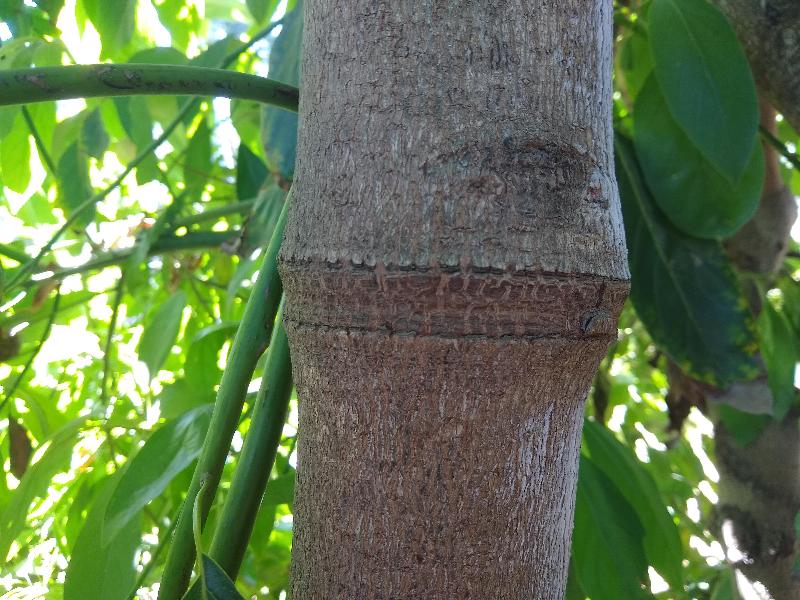
What does girdling do to the tree?
When the sap flow is stopped with a girdle at the correct time, the branch will flower heavily the following spring and likely set a lot of avocados.

When to girdle?
I have found that girdling near Halloween is effective, at least for a Hass tree in my location (Ramona, San Diego County). Others in California have also found this an effective time, but some girdle successfully in September or November too. Every California grower that I know who girdles does so in September, October, or November.
How to girdle?
I have made girdling cuts with various saws, including the compact hacksaw with a 10-inch blade shown below. Others use various saws and knives. There is no standard avocado girdling tool.

I have found success by making two cuts with this hacksaw, maximum one-quarter inch apart.
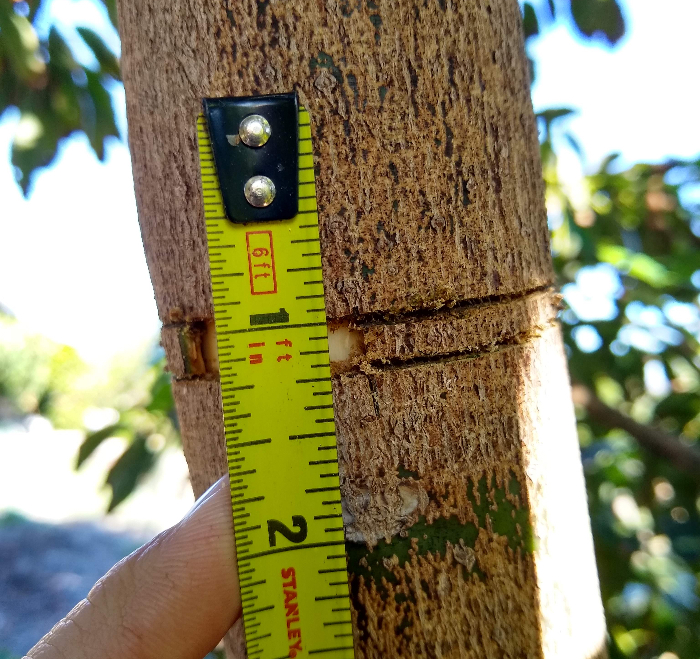
The key to a successful girdling cut is proper depth. You must cut down through the sap-conducting layer called the phloem. If you don’t, then the sap flow is not interrupted. Additionally, you must make the cut all the way around the branch circumference. If you don’t, then likewise the sap flow is not interrupted. However, you don’t want to cut so deep that you go into the inner layers of the branch because that is unnecessary and it will weaken the branch, making it susceptible to breaking.
The inner layers of the branch are harder so you can feel when you reach them, especially after some experience. To check your girdle’s depth, you can cut a window or tab and see how it peels. The bark and sap layer should peel off cleanly if you’ve cut deep enough.
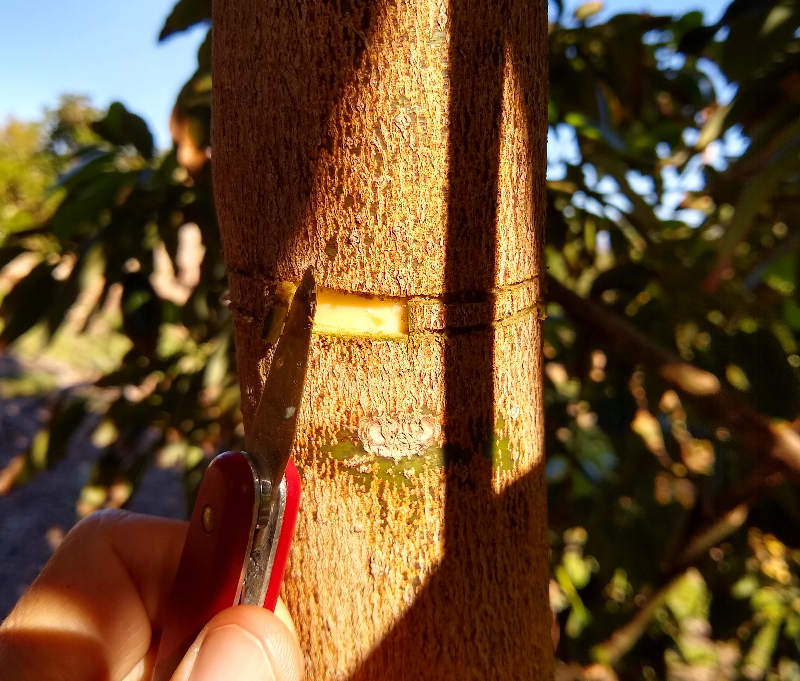
Here is a girdling demonstration by Sam Garibay of Brokaw Nursery. Sam uses a slightly wider saw and makes only a single ring around the branch. Sam is an expert in girdling avocados, and his method is probably better than mine.
How to use girdling to achieve consistent fruiting?
Girdling is used on avocado trees to achieve various goals, but here I’m talking only about using girdling to achieve consistent fruiting in a single tree, as avocado trees left to themselves will tend to have heavy crops followed by light crops followed by heavy crops. But wouldn’t it be nice to have a medium crop every year instead?
I first encountered the idea of using girdling to get a single avocado tree to yield a more consistent crop each year through an article from the 2010 California Avocado Society Yearbook by Reuben Hofshi, Mauricio Tapia, and Mary Lu Arpaia titled, “Stump and Topwork – a Technique for Rejuvenating Mature Avocado Trees,” specifically, the section titled, “Develop a two-leader tree.”
The authors recommend forming a tree with two leaders (main branches) and girdling one each fall. In this way, the tree forms fruit on about half of its canopy each year. In effect, they propose forming a single tree with two personalities. One side of the tree fruits one year, then the other side fruits the next year, back and forth, back and forth, forever.
If you started this process on a Hass tree this year, here is what the calendar would look like:
October 2023, girdle one half of canopy.
April 2024, girdled branch flowers heavily and sets fruit.
October 2024, girdle other half of canopy.
April 2025, harvest fruit from branches girdled first, in October 2023; branches girdled in October 2024 now flower heavily and set fruit.
October 2025, girdle again the first half of canopy, the half that was girdled in October 2023.
And so on.
If a tree that is 15-feet tall is capable of carrying 200 avocados in a good year and you girdle half of it, you are aiming for 100 avocados from that half, thereby getting 100 avocados every year rather than 200 avocados every other year (and near zero every other year).
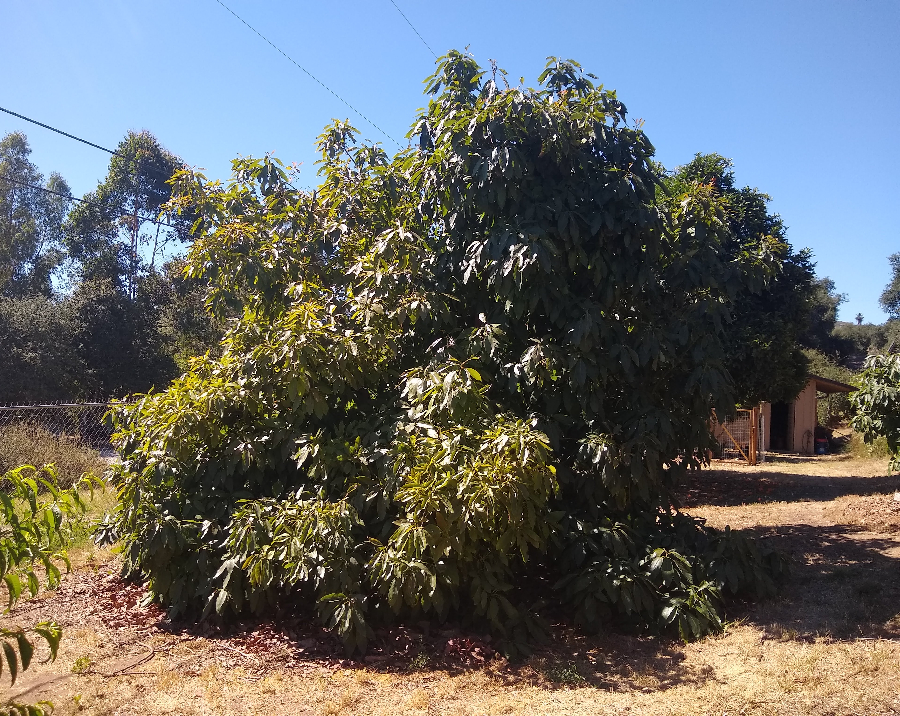
Note that when you girdle one half of a tree, you force that half to flower, but the ungirdled half compensates by doing almost no flowering. Therefore, you’re not girdling in order to get more overall fruit from a tree. You’re controlling where and when the fruit is produced.
(Girdling can increase overall fruit production in avocados in some situations though. See, for example, “Increased yield through girdling of young Hass trees prior to thinning” by J.S. Koehne of South Africa.)
Does girdling really work in the long term?
I have only been girdling various avocado trees in my yard for a handful of years. The technique is still experimental for me. While I have seen it work to achieve consistent fruiting on my Hass tree for a couple years in a row, I don’t have any further firsthand experience.
But I have visited other groves where girdling has been practiced for many years, and for those farmers it does bring consistent fruiting year after year, where each individual tree has fruit on about half of its canopy every year.

Varietal differences
Farmers I know who girdle their Hass trees for consistent fruiting do not girdle other varieties that they grow, such as Reed, Lamb, and GEM. They say that these varieties are not vigorous enough to handle the stress of girdled limbs.
(Note that girdling stresses a tree of any variety, and it should not be done on any tree that isn’t in prime health.)
I am curious to try it on Fuerte. Girdling Fuerte for increased overall production has been tried by many others in the past. Frank Koch, who wrote the Avocado Grower’s Handbook back in 1983, said that he got such good production girdling Fuerte trees over the course of nine years that it caused him to become “a true believer.” And an avocado grower in Israel in the 1990s increased his production by girdling a different branch on each of his Fuerte trees each year. (See “The Israeli Ways,” by H.L. Francis.)
This video shows results of girdling some non-Hass avocado varieties in my yard in the 2023-2024 season:
(See this 2025 post for my results with girdling the Lamb variety.)
Further learning
There is a lot more to girdling in order to get consistent fruiting than what I’ve written above. There is the question of which limbs to girdle, whether and where to prune a girdled limb after the fruit has been harvested, and more. Fortunately, some seasoned avocado growers and girdlers have made excellent presentations about the practice, which you should soak up before you venture into girdling your own trees.
“Girdling in Avocados” by Consuelo Fernandez and Samuel Garibay of Brokaw Nursery (here are the slides only, and here is the video presentation)
“High Density Pruning and Girdling” by Paul Nurre of Oro Del Norte Ranch (slides and video presentation)
Video
I made this video showing my girdling process for a Hass tree:
And here is a video update of the same tree in March 2024:
There are hundreds more Yard Posts to enjoy HERE
I love making these Yard Posts for you. I don’t put ads all over them because I want you to have the most pleasurable reading experience. Only your support allows me to do this. Thank you!

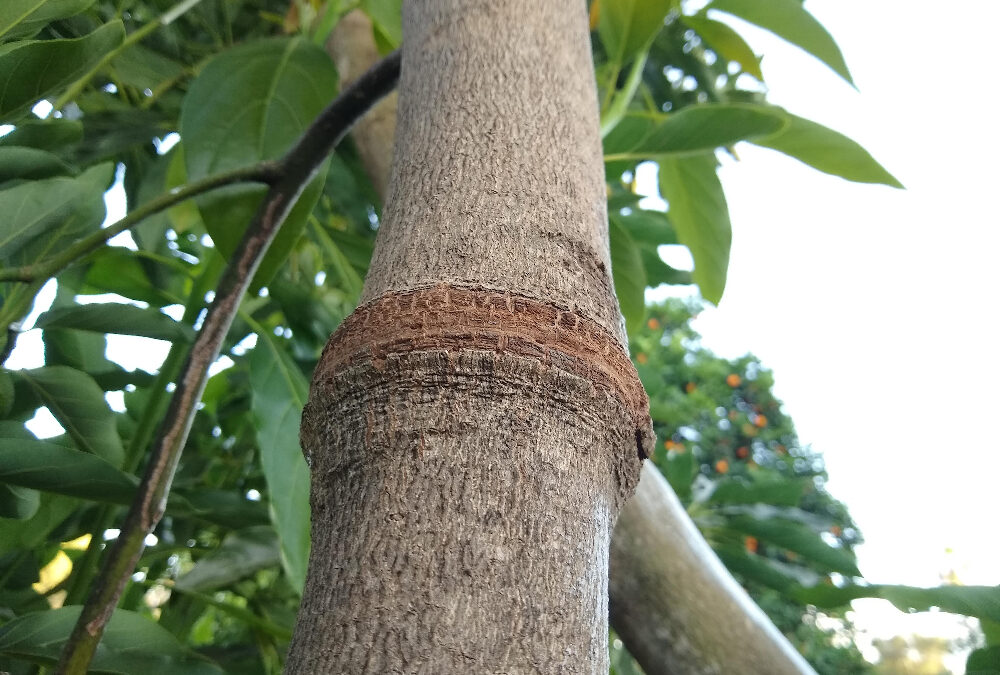


Hi Greg, I’m confused, in print you say “I have found success by making two cuts with this hacksaw one-half inch apart”. But the picture of the tape measure appears to be showing two cuts 1/4″ apart. Which is correct?
Thanx … Ken
Hi Ken,
I need an editor. You’re right. Glad I had the photo and not just the text. I corrected it. Thank you.
So this is something you do ONCE and it’s good for x number of years? Or do you have to repeat the process every so often?
Hi Joe,
The effect of the girdle only lasts one year. Once the girdle has healed, the branch acts like normal again.
So if you girdle a branch this year, then you need to girdle it again in two years if you want to cause it to flower heavily again.
Maybe I should have done this earlier this year? I had no flowers at all on our two (suspected Haas) trees this year nearer to the coast in San Diego. I’m going to have to buy avocados for the first time in two years 🙁
Which month is suitable for doing this process ?
Hi Greg, great post. We have a 50 year old Fuerte and (I think) Pinkerton in a Riverside county canyon. Would you girdle these varieties at the same time (September – November) as you mentioned for Haas, given they get ready to pick around February?
Hi James,
Thank you for your support! I would try about the same time period for Fuerte. Frank Koch wrote that he girdled Fuerte “during the month of November.” I’m not sure about Pinkerton though. It tends to set a lot of fruit and isn’t quite as vigorous as Hass or Fuerte. I don’t know how it would handle girdling and I don’t know anyone who girdles Pinkerton. If you try though, please share the results.
This is very counterintuitive. By cutting through the xylem, you’re cutting off the flow of nutrients and moisture from the roots. I can understand that cutting the phloem might restrict the flow of food from the branch into the rest of the tree, but I would think the branch would immediately wilt and die from lack of water with no xylem to supply it.
I agree, Philippe.
I don’t know exactly how it works, I only know that it works.
The girdled branch never wilts so obviously water is still getting up to its top (through the girdle). Does it travel through the wood (heart)?
Aloha Greg,
Helped a friend years ago girdle grape vines and yes they were extremely good producers of fruit. To perform girdling on my relatively young avocados may in fact produce more fruit , but will the tree be able to hold it during a heatwave. We all in the inland SD areas experienced this fall. I prepared my trees with lots of extra water and still lost 80% of my Reeds and a hand full of Hass, the Fuertes seemed to resist the drop. What to do , I’m not sure.
Mahalo,
Greg H
Aloha Greg,
I had some fruit drop after that heatwave in early September too. I didn’t see more or less on girdled trees. The pattern I noticed was that the trees that dropped the most had the most fruit to drop. I didn’t see exactly this pattern in other groves, but that seemed to happen most often elsewhere too. Seems to me that it means that the trees were carrying more fruit than they could handle through the stress of heat. I think you did what you could with the extra water.
I don’t girdle any of my mature trees with the aim of getting more fruit; I just girdle them to get fruit every year, to eliminate the fluctuation in avocado production that they otherwise have. So far it’s been successful with Hass and Lamb. I’ve been getting medium crops from those trees each year that I’ve girdled whereas previously they had made big crops followed by little crops. Through girdling, I feel like I have a little more control over how much fruit they make each year.
I believe girdling cuts through the phloem, rather than any significant portion of the xylem, which, if I understand it correctly, is the wood. The girdled branch is still able to receive water and nutrients via the xylem, but when the leaves produce nutrients through photosynthesis, they can’t send it down to the roots (via the phloem), so it remains in the branch and powers increased flowering and fruit production (along with healing of the girdled bark) in the following year. To the best of my understanding, this is what happens, but if someone with more knowledge can provide a better, more accurate explanation, it would be welcome and appreciated.
Correct. I looked it up and found a good explanation at https://cmg.extension.colostate.edu/Gardennotes/611.pdf Yes, the phloem sends sugar from photosynthesis back to all parts of the tree unless it is girdled. The xylem, the “wood,” sends water upward. The cambium layer separates the two and is the growing tissue that we graft onto with the cambium of a scion (twig). A girdled tree (assuming it doesn’t heal because of a double girdle) will die in about 3 years because the roots get no sugar and starve.
just joined..
I’m from Chula Vista.4
I’ve had this Haas Avo in my backyard for 15 years now. Bought from Home Depot, Keeps flowering each year, sometimes fruits develop to pea size then fall off.
Any suggestions on how to remedy the problem.
Thanks
Check your PH–7 and over must be treated—
I wonder if one could up the nutrients in these alternating avocado varieties and figure out if that could be why they want to rest in-between. My two producing Fuerte’s are resting this year. Both had around a hundred fruits. They bloomed not as heavy and have just a few babies on them now. The oldest Furete has very little and has had a lot of nutrient issues. My Avila avocado has 25 babies on her year 7 of age. So she is not alternating a big surprise as well. I too experiment with my trees. Mexicola Granda is one of our favorites and it can have good and not so great years. I deal with PH of 7 to 8 all the time. Treating this problem is a tough one with my clay soil and lack of acid rain. There is always a reason we just have to figure it out I think. Of course using sulfur, organic matter helps but it’s a fight to keep these trees producing. One of our problems I think it climate change.